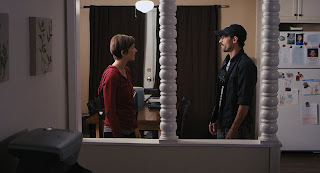Suzanne Guacci: The Making of 'Stuff'
 |
| Suzanne Guacci (center) at screening of her film 'Stuff' at Outfest Los Angeles. |
This is Guacci's fifth film, her third feature. She started out as an actress in her 20's, which she did for 10 years, performing in regional theater and indie films. She began writing to make up for a lack of opportunities that she had or wanted. She even worked as a police officer until she finally decided to start her own production company about eight years ago, leading to her first feature Cycles (2008). She never went to film school. She said she learned by doing, basically getting on-the-job training for becoming a filmmaker.
Guacci wrote the screenplay for Stuff about two or three years ago. It took her about nine months to birth the script, not that different from the time it takes to birth a baby. She shot the film in 19 days in her home town of Long Island, New York. She cast it being a fan.
Yvonne Jung who plays Debra and Karen Sillas who plays Trisha were both working actresses who Guacci had admired. Traci Dinwiddie who co-stars as Jamie was unknown to Guacci but during her late-stage casting, Guacci was impressed with Dinwiddie's physicality. Dinwiddie had notably did trapeze work.
Guacci said of the 19 days or roughly three weeks of shooting, the first week was a challenge. The young actor who played Jamie's son had to be replaced due to illness. A crew member had to be replaced as well. There was no rehearsal time. Most of the actresses came from Los Angeles where they had to prepare on their own with only phone conversations connecting them to Guacci before production began.
Guacci reported that after that initial week though, it was pretty smooth sailing. Even though her story required working with children, a class-full of children putting on a stage play, Guacci didn't note any problems. For starters, one of the children who has the most lines is her own 10-year-old daughter Maya who has been acting since she was 4. The other child with the most screen time is Brianna Scudiero who came from Guacci's town and Guacci found to be very direct-able, despite being younger.
The filmmaker also found the making of this movie to be a very collaborative process. There is one crucial scene between Debra and Jamie in Jamie's kitchen where Debra confronts Jamie about her past and her abusive ex-husband. In the script, Guacci had called for a flashback to see Jamie's past. Guacci even planned with her cinematographer to film that flashback and edit it into the kitchen scene. Yet, the actresses, Jung and Dinwiddie, expressed that the flashback was unnecessary.
That kitchen scene as it played out in the final edit was the result of Guacci working with her actresses and putting on screen a moment that works for all. It is actually even a more powerful moment as a result of listening to her actresses and testing it out for herself. Guacci indicated that she liked the collaborative process, and not just with her actresses.
She also praises the work of her editor Mike Mazzotta. She said that even though he was very different from the characters therein, he understood the lives of these 40-something lesbians. She said he was not only a great sounding board but also helped to make things clearer for her, even though she wrote the darn thing.
One notable editing choice is the decision not to use establishing shots. Guacci said her movie doesn't possess any establishing shots, or camera angles that provide a wide view of a scene or situation. She said she wanted to move from one moment to the next at a certain pace. As such, the movie doesn't ever feel slow or that it wastes time.
This is perhaps crucial because the movie ends on a quote which Guacci discovered in Gone With the Wind (1939). The quote is about the passage of time and Guacci wanted to convey that awareness of time, but she believed that awareness should be more reflective and not fear-based.
For more thoughts about the film, read my review here.
For more information about Guacci and her film Stuff, go to its website on Facebook.










Comments
Post a Comment